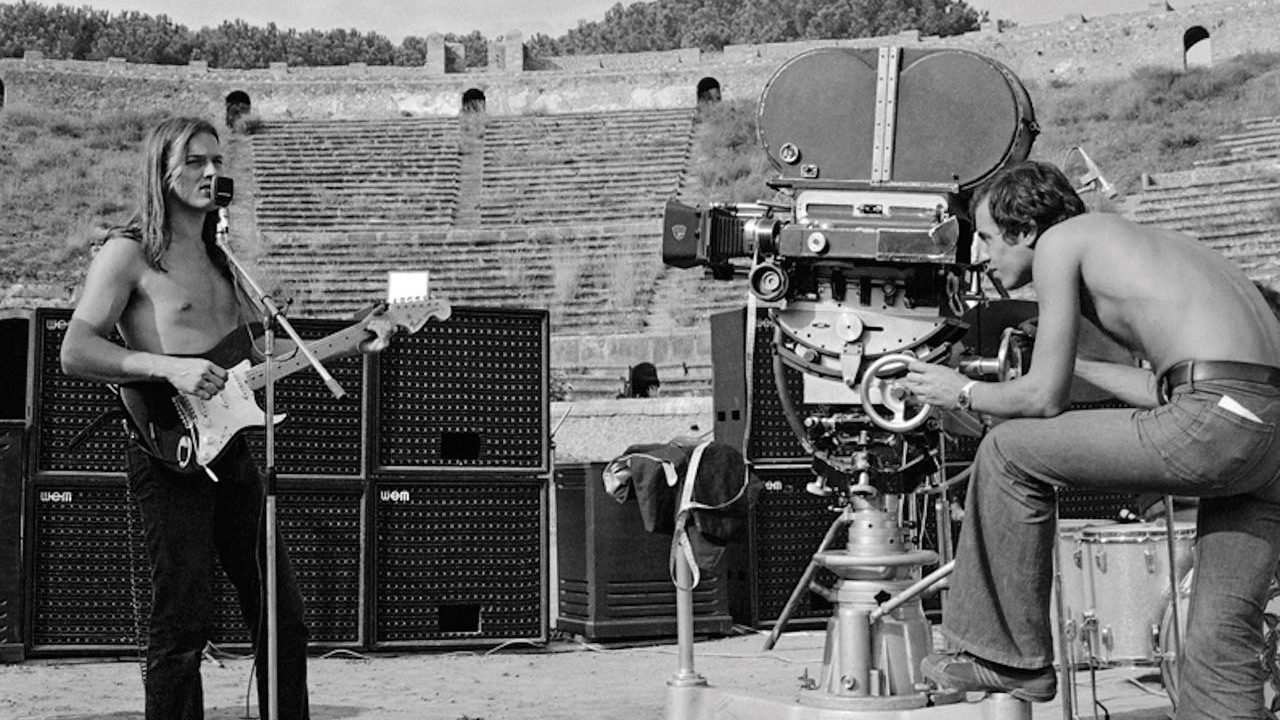In 2017, to coincide with the release of the DVD of his return to Pompeii, David Gilmour said about the film of his old band’s performance at the same venue 46 years previously: “I find it rather embarrassing. I’m sure it’s a lot of fun for many people, but not much for me.”
Of course, a great deal of what Gilmour says often comes with an inbuilt wink – at times in the past he has been very affectionate toward the film. It’s an antique and a curio, to be sure, but is it embarrassing as part of the band’s legacy? Let Prog take you on a journey back to four beautiful young men, a sultry, historical amphitheatre, and a young film director, brimming with art and ideas…
Although it was grandly billed as “More Than A Movie! An Explosive Cinema Concert”, Pink Floyd: Live At Pompeii is a small, personal film, which sets Pink Floyd, then at the tail end of their space rock phase, at the very heart of the European art scene. It crowned the era in which the group were scoring ballets, adding soundtracks to foreign art movies and recording in Paris. With a German-Belgian-French-made film set in an arena at the heart of the origins of Europe, Live At Pompeii represents Floyd as part of a continental musical movement, quite distinct from their American contemporaries.
In its own quiet and archaic way, Live At Pompeii expanded the band’s reputation throughout the 70s, in tandem with the success of 1973’s The Dark Side Of The Moon. As the decade progressed, through one-off and late‑night screenings in the UK and the US, it did their touring for them. For new fans, Live At Pompeii (as with their cut‑price sampler, Relics) catapulted the band back to another era.
The film’s second version, released in 1974, as the Floyd became glacial and removed, showed the band sharing lunch and recording in a moment of seemingly Fabs-type bonhomie. Although today these sequences bear out Gilmour’s view, it was enough for this writer and countless other viewers to be happily taken in.
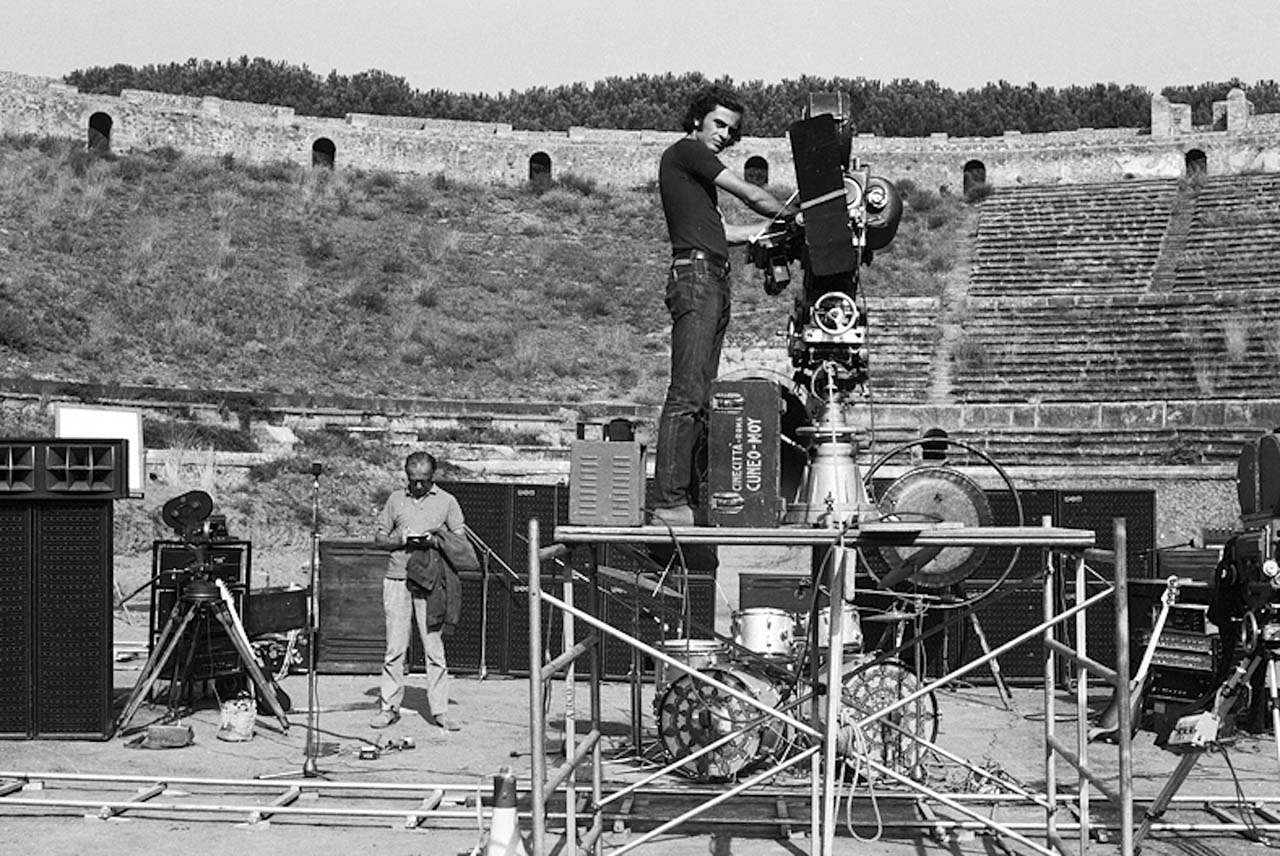
“It’s just us playing a load of tunes in the amphitheatre with some rather Top Of The Pops-ish shots of us walking around the top of Vesuvius and things like that,” Roger Waters said at the time of the film’s release. “I think Pink Floyd freaks would enjoy it.”
Although shot on 35mm, Live At Pompeii was originally made for television. Like so much in the Floyd’s career, it was a happy accident. It was the vision of UK-born, Paris-residing director Adrian Maben. Maben had not emerged from the Cambridge/London art clique that had surrounded the group. He was young and working for French television. “I was into art films, making portraits of Magritte and art movements,” Maben tells Prog from his residence in Paris. “Art became something new and vibrant.”
A Parisian youth at an exciting time, Maben had met Jean-Luc Godard and marched with the students in 1968, but despite all this, there was a general mistrust in the capital of rock music. “There were few rock programmes – it was just noise to the people who ran TV, even the intelligent ones.”
It was not the case in neighbouring Belgium. “Belgian TV was more open to the possibilities of making rock films, so I went to Brussels and did a couple of films there with East Of Eden and Family. I learned a lot.”
With these films under his belt, Maben set about ensnaring the group that he really wanted to record. Pink Floyd seemed to marry both his love of art and music perfectly. More to the point, they had piqued his curiosity – he was intrigued by them. “When you listened to their records at the time, it was very strange – you didn’t quite know how they made their sounds.
“I thought it would be very interesting to show how they made their noises, their electronic sounds, and put them all together. I found their music fantastic and different compared to other groups. You had all the little whispers, and the noises, and the shrieking. It was a different world, and that different world was absolutely fascinating.”
Maben phoned the group’s manager, Steve O’Rourke, in early 1971 and set up a meeting with him to discuss his vision, “a marriage of art and the Pink Floyd”. After this initial contact, he heard nothing. He called O’Rourke again and a second meeting was arranged, this time with David Gilmour present. Gilmour was, as Maben says, “very nice and told me they would think about it”. And then, again, nothing.
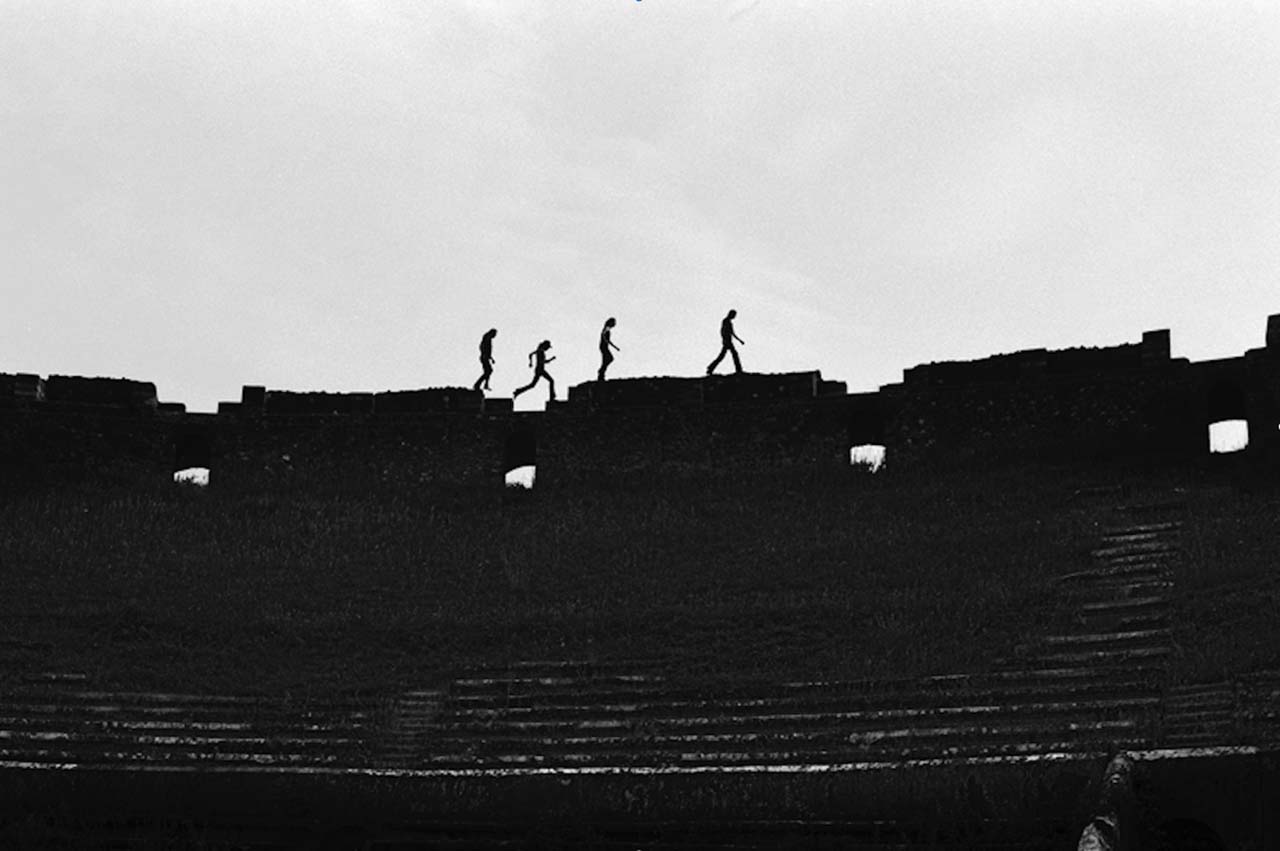
Then there was a tentative agreement – the group would film later in the year. No location had been decided on for the film. It was only when Maben was touring Italy that summer that he found his spot. He chanced upon Pompeii, the city on the outskirts of Naples that had been destroyed by the eruption of the volcano Vesuvius in AD 79, with up to 11,000 residents buried in ash. The city was first rediscovered in the late 16th century, and soon established itself as a magnet for visitors from around the world.
It was a mishap with Maben’s passport that led to him going back to the once great city’s amphitheatre at night. He thought it would be perfect for the group to play in. Maben was later to say, “It was the silence, it was the night time, it was eerie – this is the place the Pink Floyd have got to be.”
Importantly, unlike recent concert films, it would just be the group performing alone, without an audience, playing to the silence.
Putting a rock band, let alone making a film, in what was to become a World Heritage site just a handful of years later was not straightforward. Again, Maben, an extremely methodical individual, was not going to let red tape stand in his way.
Through one of the film’s producers, Maben knew of someone onside at Naples University: Ugo Carputi, a professor of ancient history. Carputi went to Haroun Tazieff, the Soprintendenza in charge of the site.
“Rock’n’roll in the centre of Pompeii wasn’t exactly their cup of tea,” says Maben. “They were frightened of a huge crowd clambering over monuments, taking away stones. I told him I wanted to do a concert where the only thing we will see is the Floyd themselves, a bit of the crew, zero spectators. That’s what finally clinched it. The Soprintendenza didn’t know who Pink Floyd was, but fortunately Carputi did – he’d heard their music and liked it.”
Carputi could get the amphitheatre closed to the public for six days.
The whole thing was to move away from, as Maben said, “the show and people reacting to the show”. Ever since the footage of the hyperventilating girls experiencing Beatlemania, the audience cutaway shot had become de rigueur in film, with Woodstock and Gimme Shelter featuring their audiences almost in equal measure to the bands. Maben was adamant that it should not be just another concert film, and he was clear that he wanted to capture Pink Floyd differently.
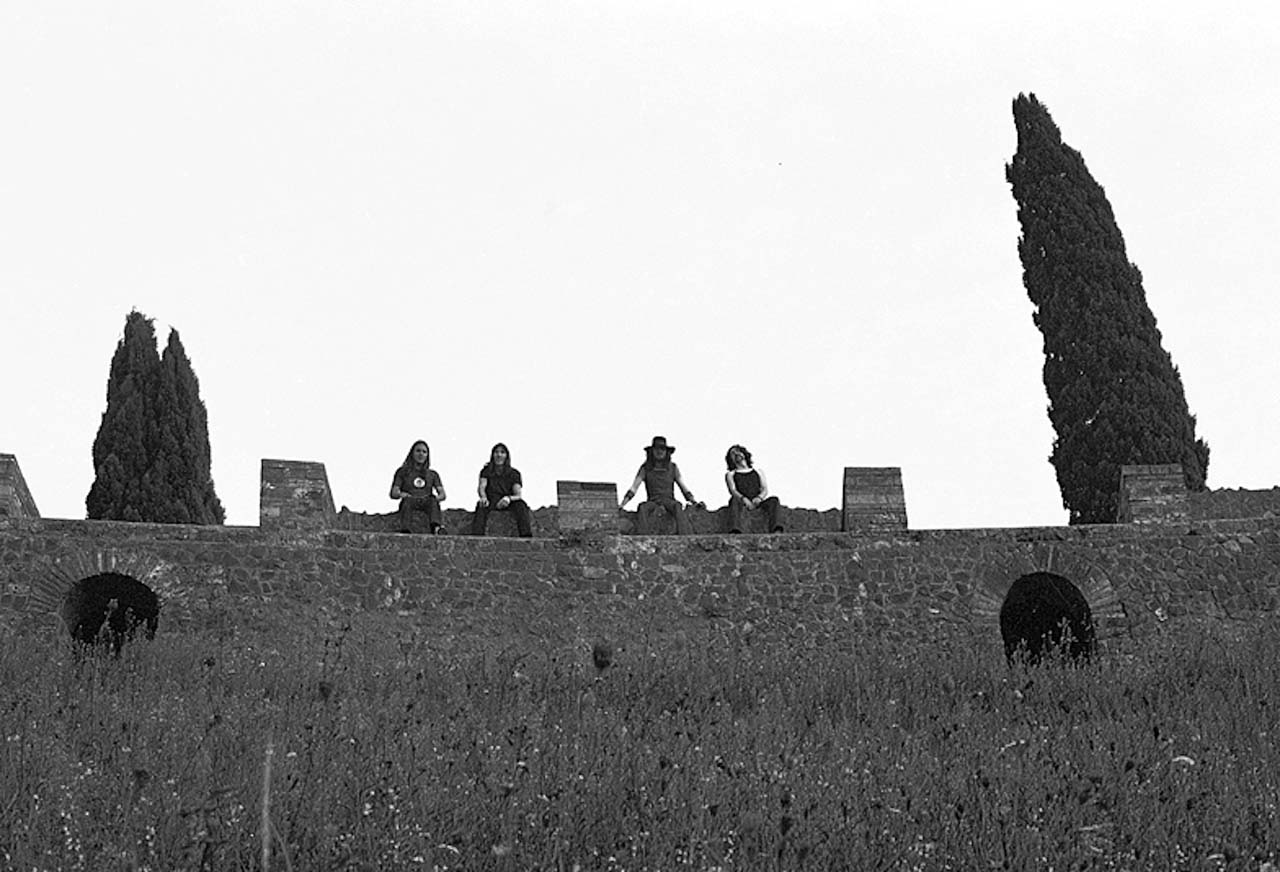
“It was to be an anti-Woodstock,” Maben continues. “Above all, there should be the notion of silence, and the images [of Pompeii] would speak for themselves with the music. It was something that had to stand on its own: the Floyd and the emptiness of the theatre. Maybe, just maybe, it was like they were playing for the ghosts of the dead. The real miracle is that Live At Pompeii escaped a TV format and became a film with international distribution.”
The film was to be made and financed for TV by the Belgian Radio Télévision Belge Francophone, the German company Bayerischer Rundfunk and the French Office de Radiodiffusion-Télévision Française. However, producer Reiner Moritz suggested that it should be filmed on three cameras using high-quality 35mm film. This contributed to the film’s longevity and success. The main stipulation from the group was that they would not record to playback – it had to be live – and they needed to make the film to full studio quality. Road manager Peter Watts pushed for full multitrack recording and for it to be as good as any studio.
“The one thing the Floyd insisted on was doing a multitrack recording and they were 100 per cent right,” Maben says. “That meant recording in situ, so the recorder came from Paris because we couldn’t get one in Rome.”
Hired from Studio Europa-Sonor, it came with engineer Charles Rauchet, who set it up in a corner and recorded everything. “He was very good, because he accepted that we would stop and start. The Floyd seemed fairly happy about it.”
As a result, the live performances are remarkable for the way the sound bounces off the stone walls. “Peter Watts said the sound had a kind of echo to it, not a dry sound like in a studio. He suggested that the Romans who built the amphitheatre thought not only of the structure but also of the acoustic qualities.”
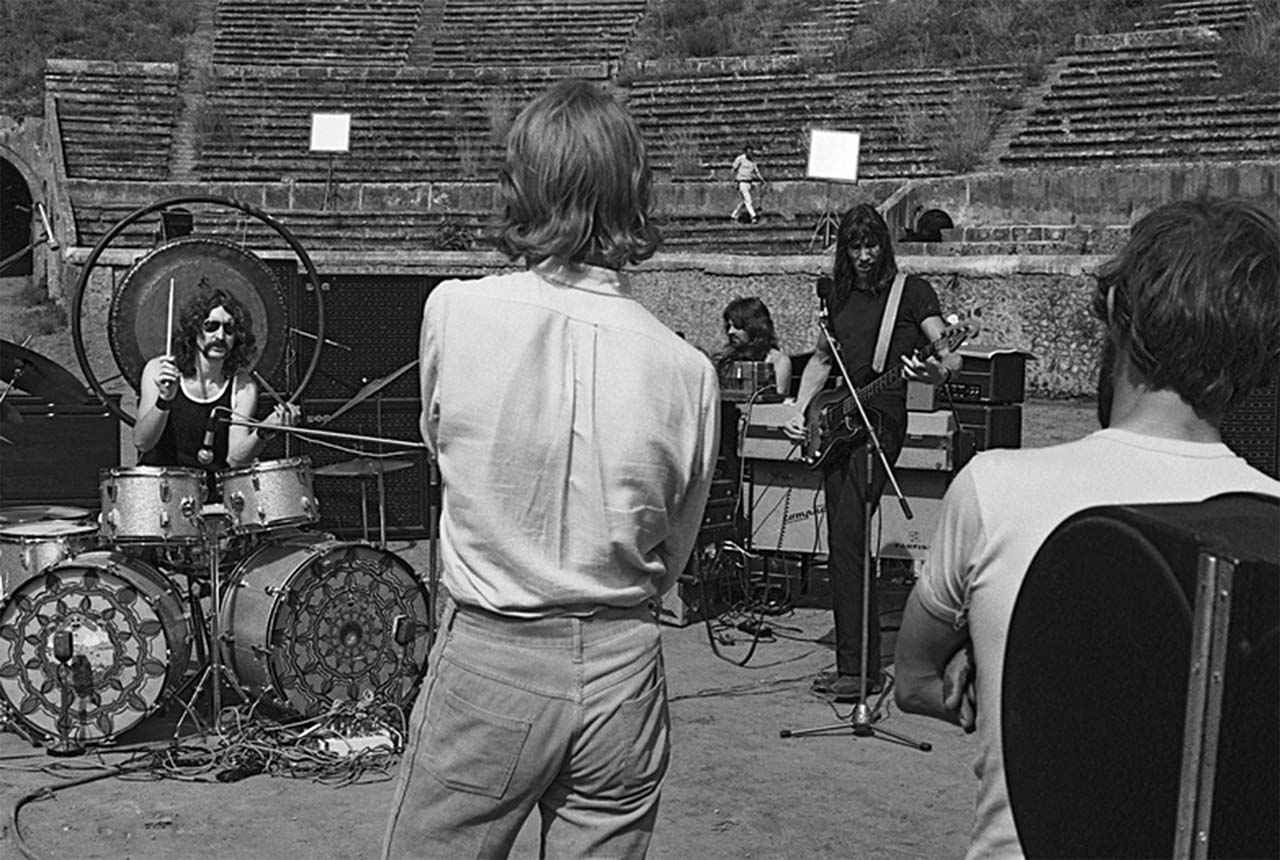
Filming took place in early October 1971, just after the end of the band’s short European tour and their recording of the BBC’s Sounds Of The Seventies at the Paris Cinema. Maben had booked six days for the shoot. The Avis trucks unloaded the group’s equipment… and then the electricity packed up.
“I’d been to see the Soprintendenza two weeks before and he assured me that the electricity would be no problem as it worked for the whole of the site. When we tested it and the Floyd were arriving, it didn’t work.”
The Floyd arrived from London, and two days passed – which meant they only had three days in which to shoot. Eventually, a cable was run from nearby modern Pompeii to the amphitheatre, meaning the filming could happen.
It wasn’t straightforward either when they went to film the cutaway shots of the group walking amid the sulphurous mud at nearby Boscoreale on the slopes of Vesuvius. That day, the band’s transport became stuck behind the annual Our Lady Of The Rosary procession in Pompeii.
On the eve of shooting, Steve O’Rourke sprang a surprise – he produced a test pressing of the group’s yet-to-be-released album, Meddle, and told Maben that the film was to feature two of its songs – and one of those songs, Echoes, was 23 minutes long.
Maben says: “Steve arrived and said, ‘Here’s what we really want to do.’ I told him that he couldn’t expect me to work on this for the following morning because I’d planned for everything else.”
A deal was struck that the group would do the new numbers and then everything else. All the camera angles and tracking were mapped out the night before shooting. Everything had to be very precise.
Maben was filming with experienced cinematographers – the Hungarian-Italian veteran Gábor Pogány and Belgian Willy Kurant, who had collaborated with Serge Gainsbourg and Orson Welles – and several people he’d already worked with, such as cameraman Jacques Boumendil and script person Marie-Noël Zurstrassen. The film equipment came from Italian studio Cinecittà, to save money on shipping it from Paris. In the end, only three numbers – Echoes, One Of These Days and A Saucerful Of Secrets – were recorded at the amphitheatre.
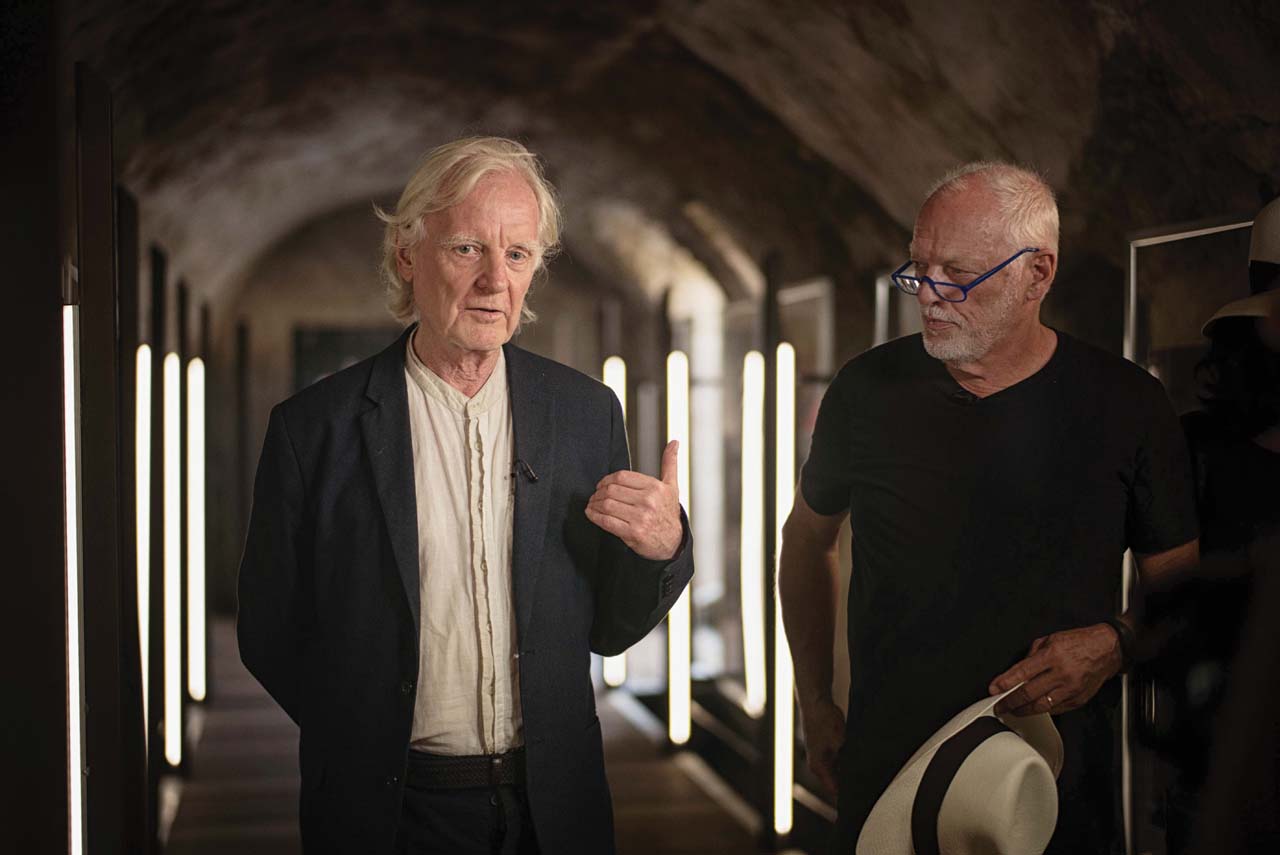
“It was hard work,” Nick Mason said in his Floyd biography Inside Out, “with no leisurely nights out sampling the local cuisine and wine list, but the atmosphere was enjoyable, with everyone getting on with their jobs.”
Probably most lovingly remembered from the film is Roger Waters whacking his gong during A Saucerful Of Secrets and the tracking shot of the rear of the wall of amps during Echoes. It’s so iconic, and the stencil on the cabinets (‘Pink Floyd. London’), with its lone full stop after ‘Pink Floyd’, is so powerful. When you think of all the money they went on to spend on kit, pyrotechnics, walls and so on, this simple lettering is equally memorable.
The inclusion of Echoes really made the film. And the final pan away, making the band look so small amid all that space, is incredibly haunting, there among all the ghosts.
“The elements that seemed to make it work,” Mason told Hugh Fielder in 2016, “none of which we really thought about during the filming, were the decision to perform live instead of miming, and the rather gritty environment created by the heat and the wind.”
After the final day’s filming on October 7, 1971, the band departed to commence an American tour. But there was still footage needed, so time was allotted from December 13 to complete the film at the Studios de Boulogne near Paris. Waters and Gilmour also suggested that some overdubbing of the Pompeii sound was done at the nearby Europa-Sonor studio, which was where Edith Piaf recorded.
“We spent a whole day working with Charles Rauchet, eating oysters, drinking a few beers, joking and working,” Maben recalls. “It was a wonderful experience that I will never forget. That was filmed with a small black-and-white 16mm Éclair Coutant camera.”
That footage was later to surface in the film’s 2003 Director’s Cut. This could be viewed as rather embarrassing. Waters and Gilmour look as if they have had a private competition to see who could appear more wasted. Waters performs his well-worn obstreperous shtick when asked, “Are you fairly happy about the film?” He replies, after ostentatiously puffing out smoke rings, “What do you mean, happy?” Maben: “Do you feel it’s going in a direction that is interesting?” Waters pauses. “What do you mean, interesting?”
For someone who downplayed drug use, he looks out of his gourd.
The Studios de Boulogne sessions spawned new versions of Careful With That Axe, Eugene and Set The Controls For The Heart Of The Sun. “We had to do some recuts of songs in Paris for continuity, and they tried to convince me that I wouldn’t notice in the final thing,” Gilmour told Rolling Stone.
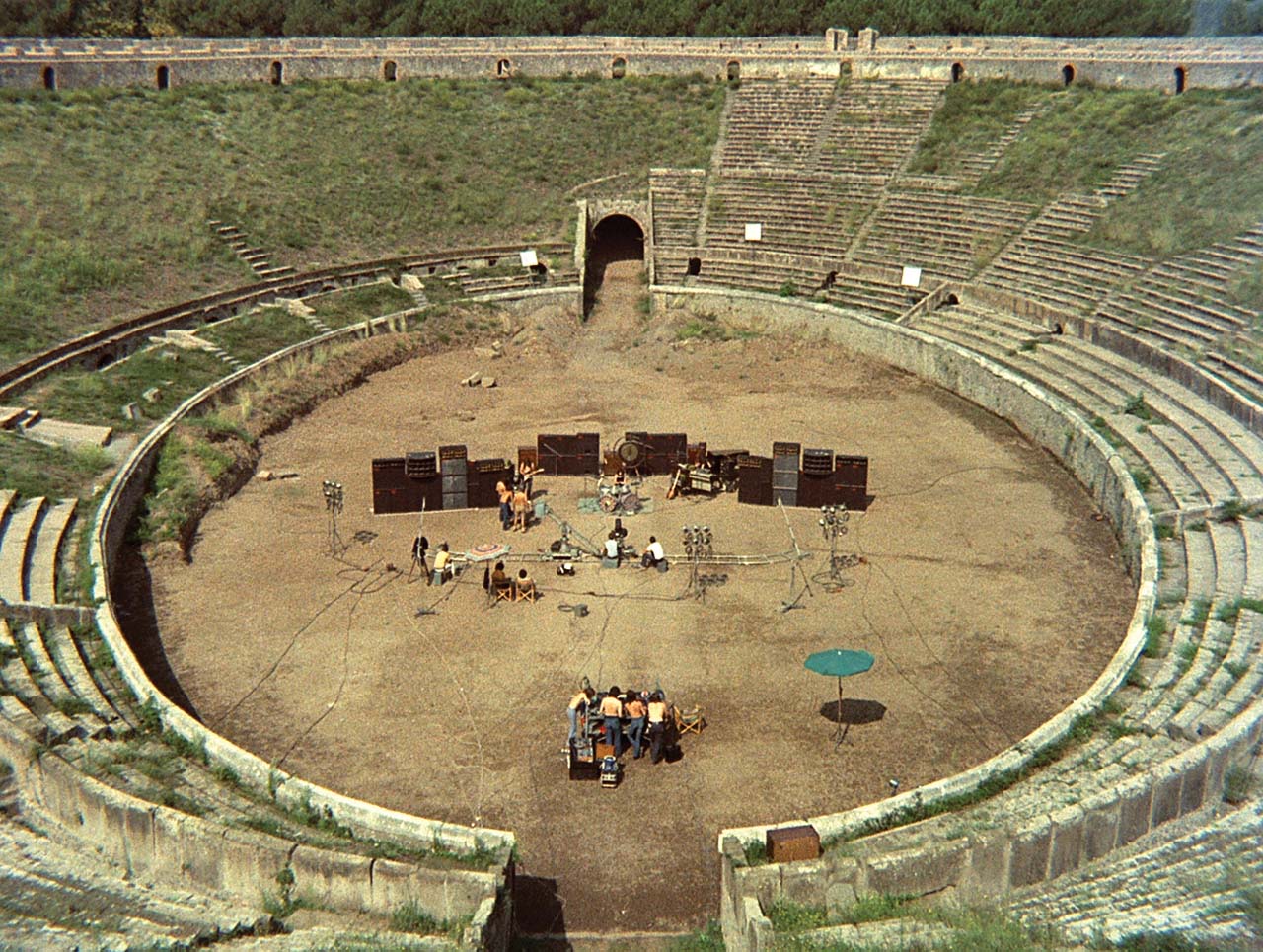
Rick Wright had had a shave, and the band performed in front of a huge screen showing Transflex projections of them recorded at Pompeii. Although the band and director weren’t keen because of the tight timescale and budget, it had to stay – and it adds tremendously to the film’s charm.
“I think if I’d not told anybody it was done in Paris,” Maben ruefully adds, “I think everybody would have thought the whole thing was done in Pompeii.”
There was a third number recorded in Paris. Floyd are not known as a ‘fun’ band, but Mademoiselle Nobs, the second of Floyd’s canine quadrilogy (after Seamus, and before Dogs and Dogs Of War), was recorded with Maben’s friend Madonna Bouglione’s Afghan Hound, Nobs. The images of Wright holding the mutt at a microphone while she moaned over Waters and Gilmour’s generic blues is possibly not the group’s greatest achievement, but it’s a wheeze.
The original hour-long cut of Live At Pompeii was premiered at the Edinburgh Film Festival in 1972. Maben only knew this after reading a snippet in the newspaper the following day. The film was to be shown on November 25, 1972 in London. Some 3,000 fans turned up for a screening at the Rainbow Theatre in Finsbury Park, only to be turned away as there was a clause in the lease of the Rank-owned venue that meant it couldn’t do anything that would compete with its cinema chain. On top of that, it couldn’t be shown as it had yet to be properly certified. Waters was asked his opinion of the Rainbow fiasco. He answered: “Rank.”
Maben felt there was still work to do. “In the summer of 1972, I began to suspect that something was missing in the first version of the film. The band played like frozen statues in the amphitheatre, but we knew nothing about their character or how they create and produce their extraordinary sounds. I went fishing with Roger on the River Teme near the Welsh border and asked him if it might be possible to film them recording their next album. Roger replied that he would think about it and ask the other members of the band. A few months later, he rang me in Paris and told me, ‘OK, we’ll do it. Come to London next week with a minimal crew and please, no interference with our work.’”
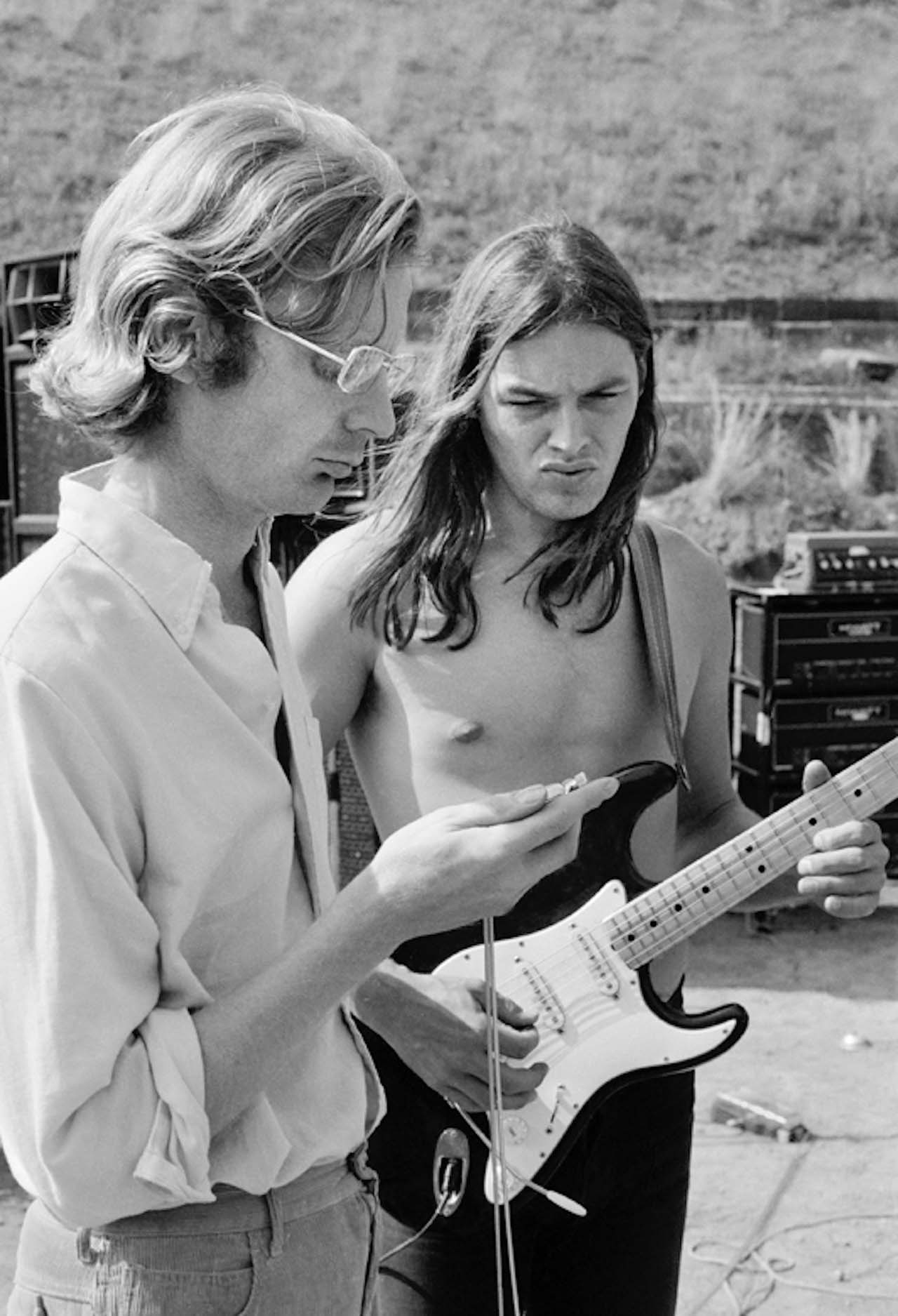
Maben arrived with a small crew at Abbey Road on October 16 and remained around Studio 2 for a couple of days before getting “politely thrown out”. “He came to Abbey Road where he filmed us finishing off the recording of The Dark Side Of The Moon,” Gilmour said in 2017. “It captured a moment in time.”
It was this footage that extended the film to 80 minutes, and became the version that gained a general release in the summer of 1974.
Waters said, “He came to London and shot us… for a couple of days, which has made it much more lively and it’s quite an entertaining film.”
Reviews for this version of Live At Pompeii, however, were mixed: Cash Box magazine said the film went “beyond perfection”, while Melody Maker reckoned it was “a Zappa‑esque musical pastiche”. Billboard weren’t keen – they called it a “floaty film of ancient statues and artefacts, sunstruck shots of the boys cavorting carelessly over the hills, and cheap psychedelic atmosphere stuff that looks left over from the mid-60s mixed-media shows”.
Some of the confusion may have come from how the film was billed – “At Last The Rock Wizards Are Unleashed On Film” and “More Than A Movie!”
“The movie is not particularly explosive and certainly not ‘more than a movie’,” Billboard sniffed. “It is, in fact, rather dull, unimaginative and hokey and does not do justice to the Pink Floyd vision.”
All of this meant nothing to the group’s legions of fans, who quietly set about seeking out and loving the film as it appeared fleetingly in one-off screenings and, that pre-video stamping ground of the rock movie, late-night cinema.
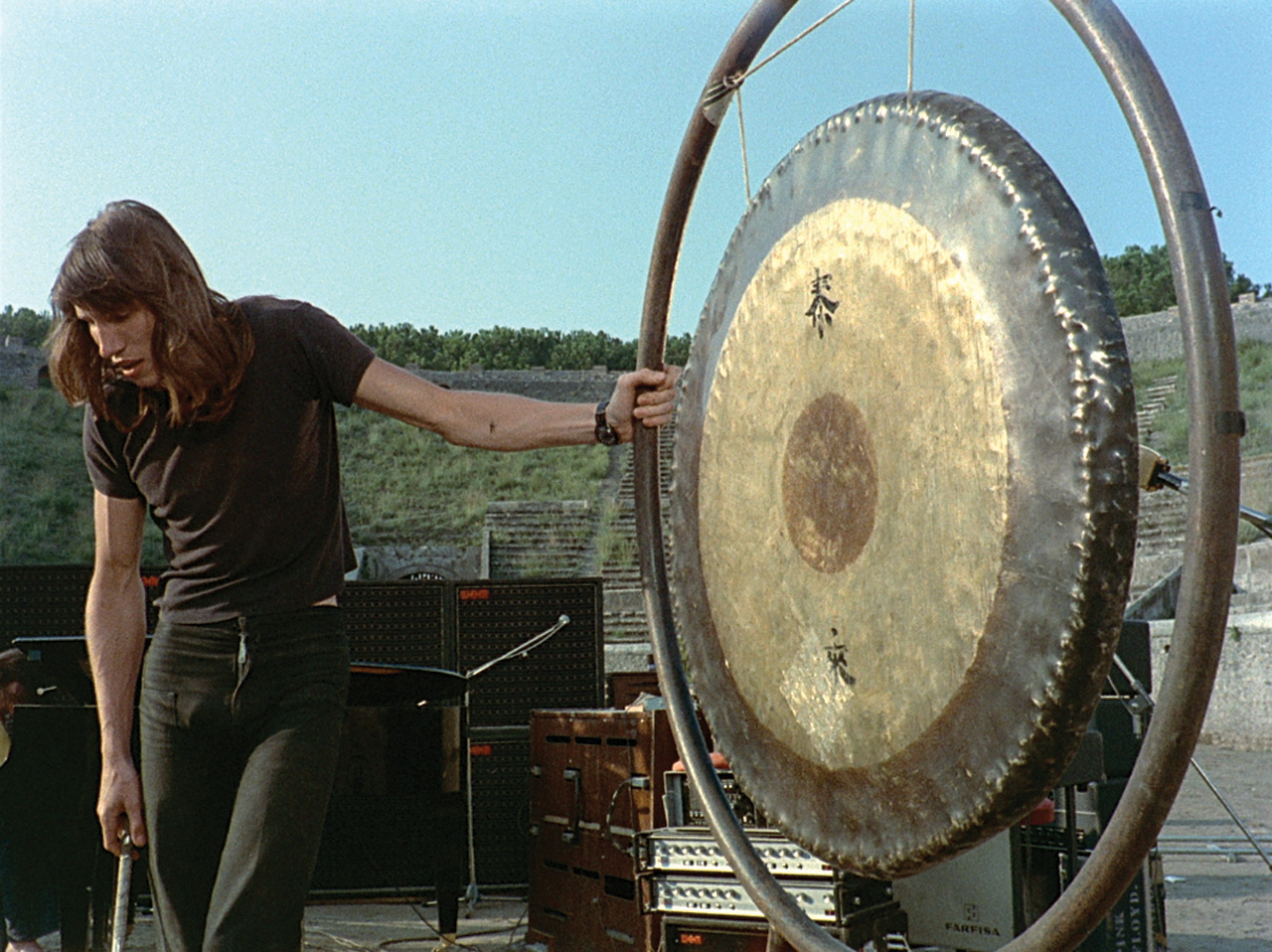
“It was the American midnight circuit that was the key to understanding the modest success of the film,” Maben says. “Philippe Borak, based in Cincinnati, was the original American film distributor, but it was George Ritter, based in Canada, who was responsible for the film’s cult status. George understood that the students on the campus of North American universities were looking for something different. The operation was referred to as the ‘midnight circuit’ and George sent the heavy 35mm cans of film to as many cinemas as possible in North America. It was a brilliant idea because the other cinemas in the malls were for old people who watched Hollywood blockbusters. Live At Pompeii was not their idea of fun at all.”
In the UK, the film frequently went out on a double bill with Tony Palmer’s short film of Fairport Convention and Matthews’ Southern Comfort live in Maidstone in 1970.
Live At Pompeii marks closure for the European Floyd, before America tried to drag them to its breast. It’s nothing to do with stadiums, cherry bombs, firecrackers or good times – it’s Floyd, alone at the cradle of modern civilisation, making unusual, space-focused music, on the site of one of the greatest natural disasters in history, with the sun and its rays reflected off the walls and their gong. Pompeii itself, and its incredible October light, is in many ways one of the stars of the film. Its majesty, eeriness, sense of broken progress, of a civilisation brought to its knees, suited the Floyd and their audience’s cosmic consciousness.
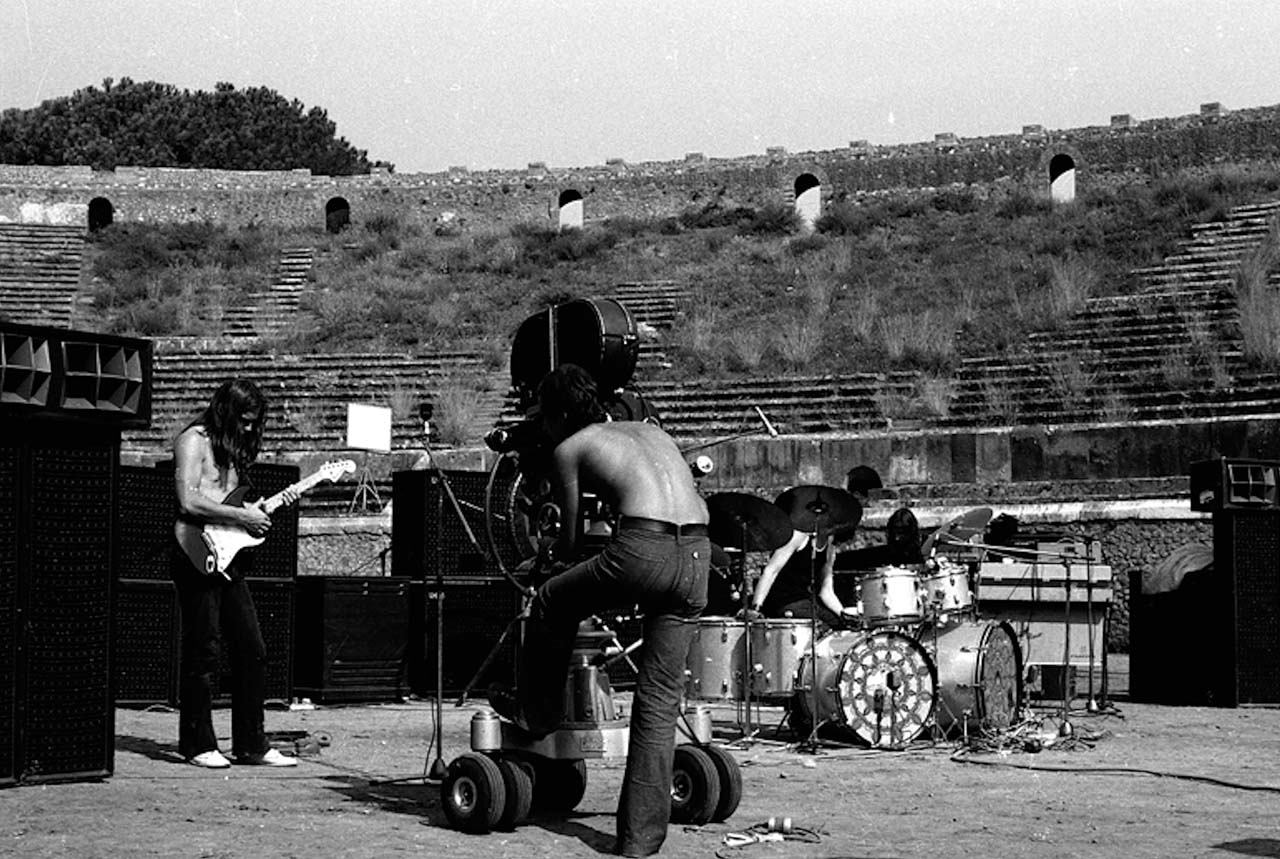
And the band’s look was crystallised in that moment: Waters in his black T-shirt with the haircut that eventually every comprehensive schoolboy had in the early 70s; Wright with his shirt off, obscured by a beard; Gilmour looking like someone who had just come to life from an Etruscan fresco in Pompeii; and finally, Mason, captured in his all-time classic look, all tache and curls, looking like David Bedford, the contemporaneous UK Olympic long-distance runner and the initial inspiration for the 118 TV adverts.
What made Live At Pompeii unique for its time was that you saw all the workings of a pop group. The Beatles had attempted to do this with Let It Be, wishing initially to film their rehearsals and culminate in a gig on an ocean liner or at the pyramids, but instead ending with a downbeat show on their office rooftop.
With Live At Pompeii, there’s no artifice. You can see all the wires and a band at work. This is what makes it so intriguing.
“The band at work is exactly what we wanted to get,” Maben says.
The juxtaposition of their barrage of technology in that ancient, empty place never ceases to excite. And although the trucks that drive in the equipment have dated, as have the players, the rest is timeless.
Live At Pompeii is never less than vastly influential, and a capture of beautiful young men finding their feet. But is it, as Gilmour suggests, embarrassing? There is, when anyone is presented with footage of their younger selves, an immediate instinct for one’s toes to curl. Gilmour spoke of himself in 2006 as that “young chap”, saying, “If I hear him speak, like in Live At Pompeii, I do find it excruciating, because he was pretentious and naïve.”
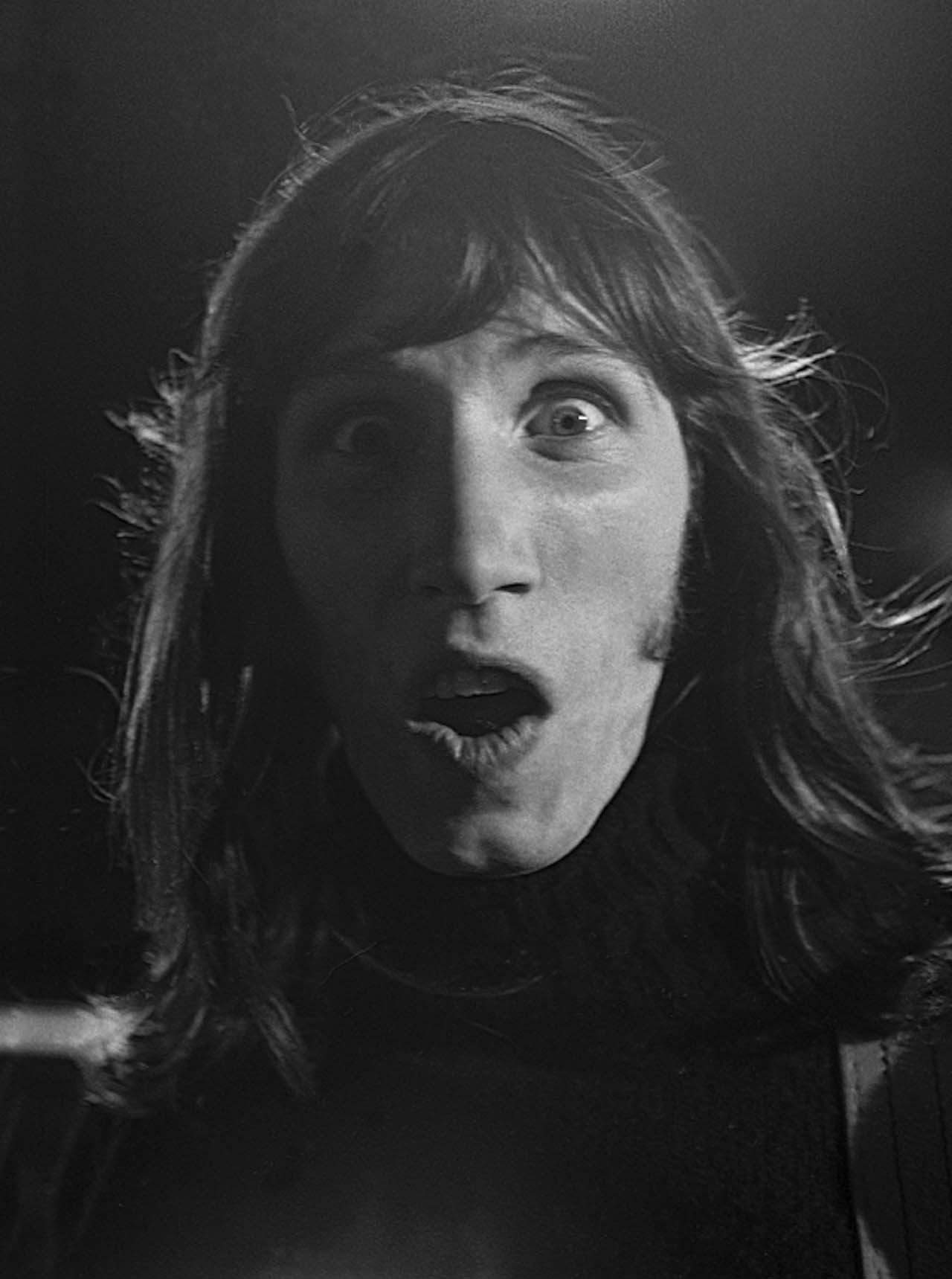
Gilmour, of course, is never one to look back that often. He added in 2017: “Doing the actual recording in the amphitheatre back then in Pompeii was great, but we had to turn it into a more interesting document of what was going on. Adrian wanted to make an art film with art and music in a special place. So the idea changed a bit and it felt to him and to us that more stuff was needed.”
“They were curious, I think,” Maben says. “They wanted to explore different avenues visually and on the music side. They did the ballet with Roland Petit. No other rock group that I can think of would have done that at the time.”
Maben was subsequently asked to repeat his formula – Deep Purple at the Taj Mahal or The Moody Blues in the Grand Canyon – but the very fact he didn’t helps the film retain its uniqueness, and that the Floyd never made another conventional performance film in their heyday keeps it pristine. Like the albums it primarily showcased, it still remains a rite of passage for new generations of fans everywhere.
Roger Waters was in favour of the film: “I liked it because it’s just a big home movie.”
Although Rick Wright didn’t say a lot on record about Live At Pompeii, his comments in the Paris segment of the film have gone on to be possibly the most heard of all. “We’re very tolerant with each other, but there are a lot of things unsaid as well.”
These words were to open 2014’s The Endless River, Gilmour’s coda to Pink Floyd, and tribute to Wright.
“I don’t think any of us thought it [Live At Pompeii] would be as well‑received and last in people’s minds for as long as it did,” Gilmour said in 2015. “All credit to him [Maben]. It’s his idea and it was great.”
Perhaps Live At Pompeii wasn’t that embarrassing after all.
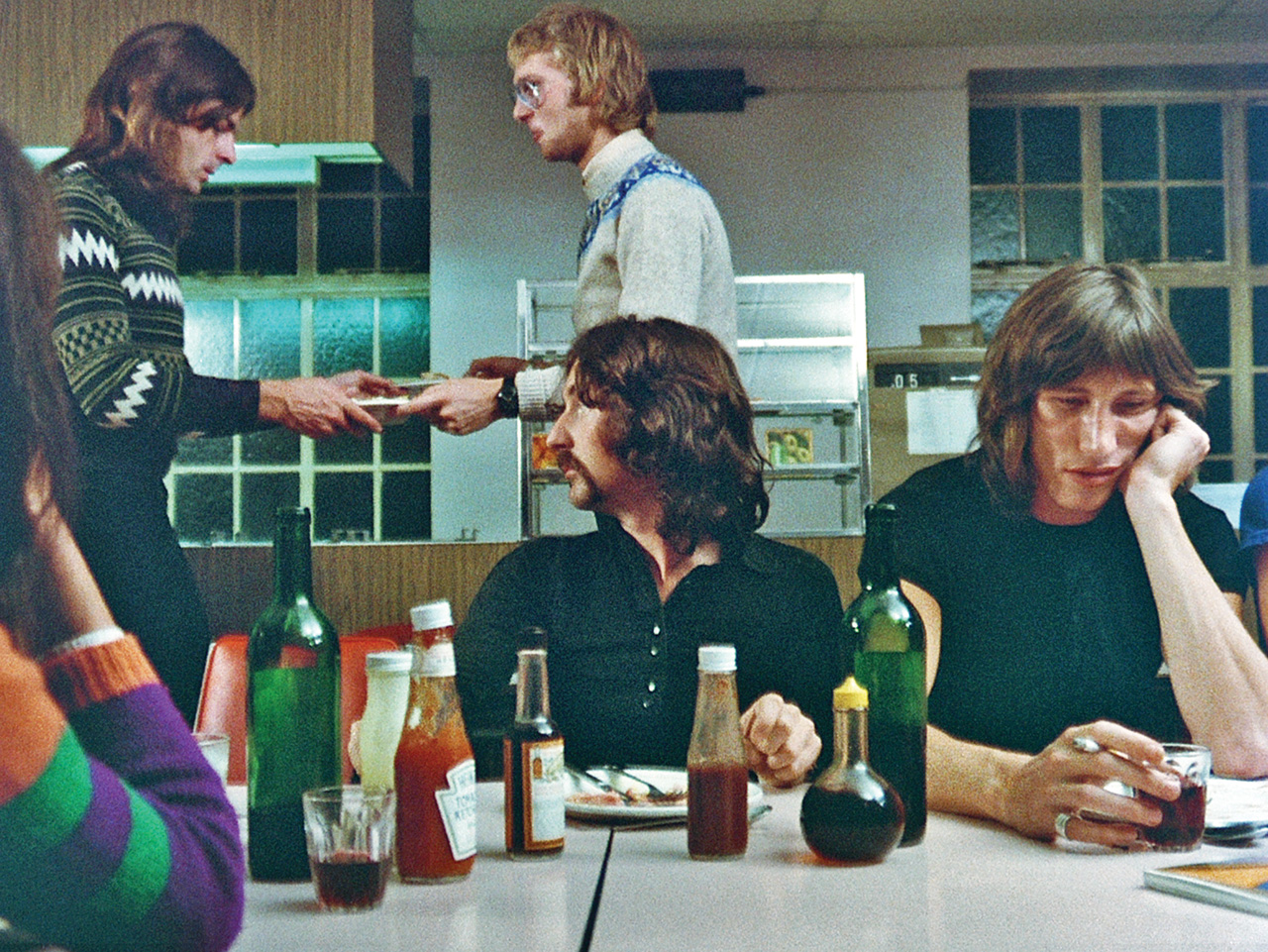
Eggs, sausage, chips and beans and a tea
Behind the scenes at Abbey Road on the Director’s Cut of the film.
The second version of Live At Pompeii, with its infamous Abbey Road canteen sequences, has been said to diminish the film’s mystique. Before the days of being coached on how to present to camera, the group appear as an unruly bunch of kids trying to act grown up.
In fact, as the road crew pass around Allen Jones’ art book Figures, the discussions between the group about the glasses of milk and apple pie “without crust” could almost be like the Haribo adverts for sweets which are on UK TV at the time of writing, which replace adult voices with those of children. Here are some of the choice quotes from these fabled exchanges.
Gilmour: “Can I have a glass of milk please?”
Mason: “How do you know this isn’t yours?”
Wright: “Because it hasn’t got peas on it.”
Mason: “Well, this has got ham on it.”
Wright: “Is this your milk, can I drink it, have a sip?”
Mason: “I’d like some pie and not the crust.”
Elsewhere, there is a very 1972 undercurrent of man and machine: Gilmour talks about whether the equipment is controlling them or whether they are being controlled by it, while Waters adds that it’s “a question of using the tools that are available when they’re available. And more and more now there are all kinds of electronic goodies which are available for people like us to use, who can be bothered and we can be bothered.”
On whether these new machines could be responsible solely for their success, Gilmour insists, “It’s all extensions of what’s coming out of our heads,” while Waters says, “It’s like saying, ‘Give a man a Les Paul guitar and he becomes Eric Clapton.’ It’s not true. Give a man an amplifier and a synthesiser and… he doesn’t become us.”
The images of Gilmour and Wright playing are complemented by the timeless image of Waters’ veiny arms twiddling the knobs of his synth, saying, “Can I put this down? It’s just on the… It’s just on the first note?” There’s a delay; the phrase ‘Stay cool’ is said, almost as if a Vesuvius-like eruption could be encountered.
Waters is prescient in saying that rock’n’roll will not be dying any time soon. Mason also suggests that their era may be passing, and that the group represent their fans’ childhood. As this dissolves immediately into Wright playing Us And Them at the grand piano, it’s strangely moving. And then we’re back to that canteen and their fruit pies…
“Now I think about it, the main quality of each member of the band was probably a great sense of humour,” Maben says. “Roger once told me that it enabled them to avoid infighting.”
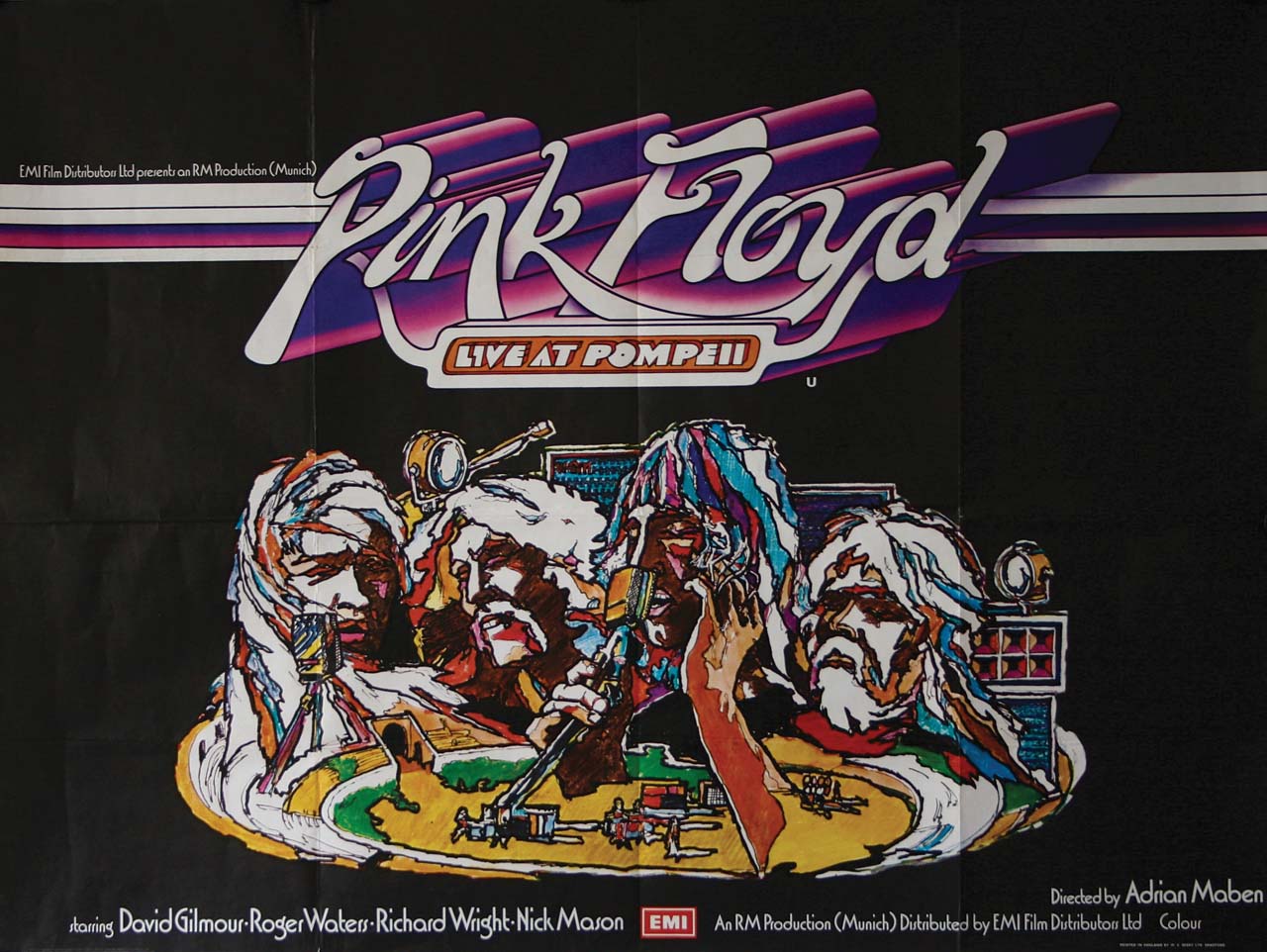
A film is never finished
There have been three versions of the film so far, released in 1972, 1974 and 2003, with another potentially on the way. Adrian Maben explains why.
“In reality, a film is never finished and one’s opinion changes over time. You don’t just put it in six cans or on a hard disc and say, ‘That’s it, let’s move on to something else.’ On the contrary, you try to find a method, and some money, to change the old version into something new that hopefully will be more contemporary.
“It’s like the French painter Pierre Bonnard, who was well known for always wanting to retouch his paintings, even when they were hanging on the walls of the Louvre. He always carried a small paintbox in his pocket and used to tell the irate museum guardians who tried to arrest him that they were his paintings and that he could do whatever he wanted with them. The word ‘Bonnardisme’ even found its way into the dictionary: ‘A discouraging tendency to be overly perfectionist!’”
Live at Pompeii tries to adapt to the extraordinary changes that are being made in cinema techniques today: from the original 35mm film shot in 1971 with a release on VHS cassettes and laser discs to the DVD version released in 2003. Now, of course, everything is on hard discs, with the possibility of releasing a 4K version in the future – and the Japanese are reported to be working on 8K television sets.
As Roger Waters once remarked, “Technology is advancing at an incredible speed and we need to take advantage of the electronic goodies that become available on the market.”
Depressed 7ft clown sings Pink Floyd's Wish You Were Here
